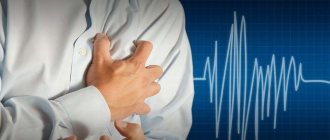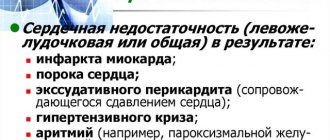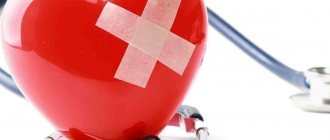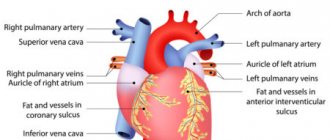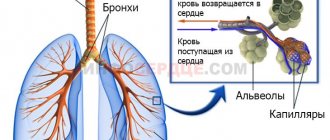The human body is a complex device. The occurrence of any disorder necessarily disrupts its functioning, which affects the functioning of organs and systems. For example, many are faced with problems such as shortness of breath and palpitations, the causes of which are related to physiological characteristics or pathological conditions. Shortness of breath, accompanied by a rapid beating of the heart, can occur as a temporary phenomenon or be permanent, indicating the presence of serious health problems.
The mechanism of shortness of breath
First of all, you should understand that this is a symptomatology that is characterized by three external signs:
- the patient feels a lack of air, he has a feeling of suffocation;
- there is a change in the depth of inhalation and exhalation, noise is heard;
- breathing becomes quite frequent.
This condition is familiar to many people, since they often experience shortness of breath during physical activity. The reasons for this phenomenon lie in the body’s desire to maintain the level of oxygen necessary for life. As a result, respiratory contractions accelerate. A signal about a lack of oxygen, the main suppliers of which are the lungs and heart, enters the brain. The respiratory center is activated. It signals the need to speed up your inhalation and exhalation.
This condition is familiar to every person. Shortness of breath after physical activity is a normal reaction of an untrained body. It can occur after fast walking, jogging, or serious cleaning. After such a load, there is a desire to catch your breath, take a breath.
This condition is quite easy to deal with. You need to start doing physical exercise. Especially for those people who lead a sedentary lifestyle. After all, their muscular system functions at half capacity. Accordingly, these contractions are not enough to support the functioning of the heart. Therefore, when performing tasks of equal difficulty, physically trained people are less susceptible to the feeling of lack of air than those who suffer from physical inactivity.
First aid
Before the doctors arrive, they do everything to alleviate the condition with rapid heartbeat and lack of oxygen:
- the patient is given a semi-sitting position with support on his hands;
- provide access to fresh air into the room;
- relieve the pressure created by clothing (remove the tie and belt, unbutton the buttons).
If the heartbeat increases sharply, lightly press on the jugular cavity and count to three. In this case, the patient should take deep, measured breaths. After a couple of minutes, the procedure is repeated. If a person continues to tremble and breathe frequently, you can give Motherwort or Valerian tincture, Valocordin drops.
Although palpitations and shortness of breath are not directly life-threatening, they can indicate serious health problems. Constant lack of air and abnormal heartbeat are symptoms that should alert a person. Only a specialist will be able to identify the cause of unpleasant symptoms, make the correct diagnosis and prescribe treatment to improve the person’s condition.
When should you be wary?
It is obvious that shortness of breath during physical activity, the causes of which are hidden in low mobility, can be eliminated quite easily. However, is this symptom always the result of such a harmless phenomenon?
Unfortunately, sometimes severe shortness of breath during physical activity can be a sign of the development of serious pathologies. It is quite difficult to independently determine when a given symptom portends unfavorable factors.
You can suspect the presence of the disease in the following way. For example, a person takes the same route every day. One day he notices that it has become difficult for him to walk. At the same time, he moves at his usual pace. There is a need to stand a little and catch your breath. Such movement with periodic stops is the first symptom of trouble. After all, as a result of ordinary physical activity, the breathing rate increases.
There are several reasons that can cause such problems in the body.
Diagnostics
A general urine test will help identify renal pathology.
To make a correct diagnosis, a complete history and examination of the cause of shortness of breath are fundamentally important. This will help to establish the factor that provokes this condition without resorting to additional research and analysis. Depending on the initial cause, examinations are carried out:
- X-ray;
- Ultrasound;
- general urine and blood tests to identify pathologies in the kidneys and determine hemoglobin levels.
Sources that cause shortness of breath
Many reasons can provoke this phenomenon. Quite common sources of such discomfort are:
- pathologies of the cardiovascular system;
- various allergies;
- obesity;
- lung diseases;
- psychogenic factors (aggression, anger);
- serious blood infections;
- climate change;
- panic attacks;
- hormonal disbalance;
- smoking;
- physiological disorders that prevent air from passing through the nose, mouth or throat.
Very often people do not pay special attention to anxiety symptoms. And he practically doesn’t think about why shortness of breath during physical activity began to occur more often. This phenomenon is attributed to the environment, hard work, and bad habits. Ignoring this problem is completely wrong.
Doctors say that in people who suffer from severe shortness of breath during physical activity, the following pathologies are most often diagnosed during the examination:
- Heart diseases. This is one of the common causes of this phenomenon, especially among older people. The heart muscle is not able to cope with its functions. As a result, the flow of oxygen to the organs is reduced. The brain also suffers from this. Such disturbances lead to increased breathing.
- Diseases of the lungs and bronchi. These are fairly common causes of shortness of breath. The phenomenon is provoked by a narrowing of the bronchi, changes in the lung tissue, as a result of which the required amount of oxygen cannot enter the blood. Under such conditions, the respiratory system begins to work intensively.
- Anemia. The patient has normal oxygen enrichment of the blood due to the proper functioning of the lungs. The heart also copes with its function. It normally pushes oxygen to all organs and tissues. However, there is a lack of hemoglobin and red blood cells (red cells), as a result of which the blood flow does not bring the necessary amount of oxygen to the tissues.
Seizure prevention
Prevention of attacks of shortness of breath and increased heart rate requires an integrated approach. Since the main causes of anxiety symptoms lie in an incorrect lifestyle, it should be radically changed.
Adjust your diet. Food should be healthy. To do this, you need to exclude drinks with a high caffeine content (coffee, strong tea, energy drinks), replacing them with herbal infusion, juices, compote or fruit drink, and mineral water. A drink based on chicory is very healthy and tasty. Instead of fried, fatty, spicy foods, introduce dairy products, fiber-rich vegetables, and vegetable oil into your diet. It is recommended to eat more bananas, baked potatoes, and various types of dried fruits. Food should be stewed, baked, boiled, or steamed. It is useful to arrange fasting days on cottage cheese, kefir, apples, and juices.
Get rid of addictions . Everyone knows that heart rhythm disturbances occur after smoking or drinking alcohol, using narcotic and psychotropic drugs. To prevent shortness of breath and arrhythmia, you should quit smoking and drinking, and give up other bad habits.
Loads . A prerequisite for successful prevention of attacks of respiratory distress and tachycardia is physical activity. Involvement in gentle sports helps train the heart muscle and improves its function. During exercise, breathing is done correctly, which is also good for health.
Physical activity . If for some reason physical activity is contraindicated, it is useful to walk in the fresh air every day in any weather. Long leisurely walks help normalize the functioning of the cardiovascular and respiratory systems.
Positive emotions. You should protect your body from stressful situations, nervous breakdowns, mental overloads, which contribute to increased blood pressure, increased heart rate, and shortness of breath.
It is especially important to prevent tachycardia in children from an early age. This will strengthen the heart and minimize the risks of developing cardiac diseases. Prevention measures also include a healthy diet, a regimen of activity and rest, staying in the fresh air, and hardening.
Heart failure
In this case, shortness of breath is observed with little physical exertion. For example, this condition can occur while walking. With further progression of the pathology, shortness of breath persists for a long time, including at rest and during sleep.
As a rule, this condition is accompanied by the following symptoms:
- swelling of the legs;
- heartache;
- bluish tint to the fingers, tip of the nose, feet, earlobes;
- periodically increasing heartbeat;
- low or high blood pressure;
- fatigue, weakness;
- dizziness, periodic fainting;
- dry cough that occurs in paroxysms.
Arrhythmia and sports
Tachycardia is a diagnosis with a favorable prognosis if treatment is started on time. Heart training begins with light to moderate intensity exercises:
- Swimming.
- Normal walking.
- Nordic walking.
- Slow jogging.
- Yoga.
- Exercise therapy.
Swimming uses all muscle groups with a slight increase in heart rate. Water pushes out the human body, thereby reducing the load on the heart. In the first stages, you need to practice under the supervision of a coach, since, despite its low trauma, this sport is dangerous for beginner swimmers.
Nordic walking has gained popularity as a means of preventing diseases associated with the development of the atherosclerotic process. The level of harmful cholesterol in the blood decreases, which means that the risk of blocking the lumen of the coronary arteries and veins is reduced. This preventive measure is chosen by those who are bothered by leg cramps.
The decision to engage in jogging or brisk walking must be approved by your doctor. The patient applies more force during these exercises. Moderate intensity physical activity is not compatible with chest pain and fainting.
Breathing exercises are useful. The blood is enriched with oxygen, but slight dizziness and nausea may occur. If other symptoms appear, you need to stop training. Breathing exercise diagram:
- Take a deep breath through your nose.
- Hold your breath for 10-15 seconds.
- Exhale slowly through your mouth.
Other sports should not be high intensity. Long-term aerobic exercise is contraindicated for patients with arrhythmia.
Hypertonic disease
High blood pressure overloads the heart. As a result, the pumping function of the organ is disrupted. This provokes shortness of breath. Prolonged neglect of this problem significantly aggravates the patient's condition and leads to the development of heart failure. The patient often experiences shortness of breath after physical activity, even a small one. And with a hypertensive crisis, the symptoms increase significantly.
With this disease, along with shortness of breath and high blood pressure, the following series of symptoms occur:
- facial redness;
- dizziness;
- fast fatiguability;
- periodic heart pain;
- flashing spots before the eyes;
- headache;
- noise in ears.
The heart beats often and it’s difficult to breathe: what’s the matter?
Normal breathing rate is 16-20 movements per minute. Shortness of breath or dyspnea is a disorder that is characterized by changes in the depth and rhythm of the respiratory process. Inspiratory type disturbance occurs on inspiration, expiratory type - on exhalation. Sometimes a mixed form is observed. In everyday life, shortness of breath periodically appears in every healthy person - adult or child. As a variant of the norm, it is called physiological and goes away after the cause is eliminated (running, physical activity). In situations where difficulty breathing persists for a long time and causes discomfort, you should think about the presence of some pathology.
More about symptoms
Shortness of breath due to arrhythmia is a symptom that accompanies many different diseases. Doctors call the main signs of this condition:
- rapid heartbeat and shortness of breath;
- the growing feeling of suffocation that a person experiences;
- change in breathing pattern - it becomes more frequent;
- combination with swelling, wheezing, whistling.
Dyspnea can occur in various forms (subacute, acute and chronic) and has several degrees. The severe stage is detected in patients who experience discomfort at rest, with slight movement or the slightest household stress.
The most common causes of the condition
There are many pathological conditions that manifest themselves in the form of shortness of breath. Conventionally, they can be divided into three main groups:
- cardiovascular disorders;
- respiratory diseases;
- anemia.
Shortness of breath may appear in case of hyperthermia, be a consequence of smoking or drinking alcohol, or develop while taking medications or osteochondrosis. Depending on the etiology of the condition, treatment tactics are selected.
Lung problems
Pulmonary dyspnea is an inspiratory disorder caused by almost all diseases of the respiratory system. When it occurs, a person’s breathing becomes difficult and the heart beats rapidly. The reasons for this condition are:
- smoking;
- respiratory tract infections;
- bronchitis;
- obstructive pulmonary disease;
- pneumonia.
Attention! Against the background of these symptoms, tumor processes, emphysema, tuberculosis, pulmonary actinomycosis, pneumothorax, and sarcoidosis can develop.
Cardiovascular pathologies
Shortness of breath caused by heart pathologies is considered the most important symptom, and in most cases has a chronic course. By the degree of its severity and combination with tachycardia, one can judge the nature and stage of heart failure. The most common causes of difficulty breathing and rapid heartbeat are the following cardiac phenomena:
- heart failure;
- heart defects;
- myocarditis;
- atrial fibrillation;
- acute coronary syndrome;
- cardiomyopathy.
Heart failure is a term that describes not a specific disease, but disorders of the heart caused by the development of its morphological changes. The syndrome is characterized by difficulty breathing, which is initially observed only during walking or physical activity. As it progresses, shortness of breath becomes permanent and appears even at rest.
Symptoms of cardiac dysfunction that often accompany shortness of breath include:
- weakness in the legs and arms, drowsiness, palpitations;
- arterial hypo- or hypertension;
- cyanosis - a bluish tint of the skin on the fingers, toes, earlobes, nose, feet;
- frequent dizziness, fainting;
- paroxysmal dry cough, especially during rest hours;
- nocturia – increased urine production at night;
- periodic pain in the heart.
The problem of shortness of breath and rapid heartbeat that occurs against the background of heart failure is dealt with by therapists, cardiologists, and neurologists.
Attacks of VSD and neuroses
Vegetative-vascular dystonia is a syndrome that combines many diseases that are similar in their manifestations. It develops against the background of stress, neuroses, endocrine pathologies, physical and mental overload. Paroxysms occur suddenly and can last from 10-15 minutes to 2-3 days, and all this time the heart continues to beat at an increased rate. During the attack and after it ends, hemodynamic deterioration occurs, due to which the organs do not receive a sufficient amount of oxygen and nutrients.
The most common type of VSD is tachycardia, namely the sinus type. Shortness of breath against the background of an accelerated myocardial rhythm is mild and does not cause discomfort. The most dangerous type is considered to be the paroxysmal type, in which the heart rate reaches 220-250 beats per minute. Most often it is diagnosed in older people. An increase in myocardial rhythm can be observed even at rest. During an exacerbation, a person suffers from the following symptoms:
- general weakness, drowsiness, fatigue;
- rapid pulse;
- severe shortness of breath;
- tremor of the limbs;
- mild nausea, vomiting;
- panic attacks;
- increased sweating;
- feeling of lack of oxygen.
Attacks are repeated frequently, which is caused by stress and fatigue due to young age and immaturity of the nervous system.
Hormonal imbalance
Humoral regulation is an important link in the chain of vital processes in the body. When hormonal levels change due to a delay in menstruation, menopause, or late pregnancy, cardiac activity primarily suffers, while organic damage to the myocardium is detected in rare cases. Such phenomena lead to increased heart rate, which is called hormonal tachycardia.
Its appearance can be determined by an increased heart rate, which is complemented by symptoms of autonomic disorder:
- headache;
- feeling of lack of air;
- dizziness;
- dyspnea;
- strong noise of blows, echoing in the ears;
- painful sensations in the area behind the sternum;
- "heart jumping out of the chest."
With organic damage to the myocardium, symptoms may be supplemented by fainting states.
Temperature increase
Hyperthermia is considered one of the symptoms of many diseases. Almost always, it indicates the development of an inflammatory process, which, regardless of etiology, provokes increased production of various enzymes and specific substances. Together, they have a special effect on the thermoregulation center, causing an increase in temperature. Trying to cope with the changes occurring, the body begins to intensively secrete sweat.
Due to the lack of oxygen, which is necessary for the reaction to proceed normally, breathing becomes more frequent and the load on the heart increases.
It is important to know! When the temperature rises even by one degree, the frequency of myocardial contraction in an adult increases by 10 beats. The child suffers even more; this figure is 50% higher. In a newborn and a year old, the heartbeat can reach 150 beats/min.
Anemia
Anemia is characterized by a decrease in the level of hemoglobin in the blood. It acts as an independent disease, or is a symptom of pathological disorders. It can develop against the background of problems with the digestive system, infectious diseases or vitamin and mineral deficiency. Iron deficiency anemia occurs most often.
Shortness of breath is formed due to a violation of hemoglobin synthesis and the production of red blood cells. As a result, the transport of oxygen molecules to the cellular structures of organs and tissues deteriorates, which inevitably leads to hypoxia.
A person develops shortness of breath and a number of other signs appear:
- general weakness;
- fever, chills;
- impaired coordination and reflexes;
- trembling in the body and palpitations.
An increase in the size of the liver can often be observed, and mental disorders are also detected.
Bad habits
Chronic fatigue, excessive consumption of alcoholic beverages, caffeine-containing products, smoking strong tobacco or a large number of cigarettes, addiction to drugs (even light ones), lack of sleep and wakefulness negatively affect well-being and over time lead to the development of shortness of breath and rapid heartbeat. Getting rid of addictions, restoring the correct alternation of periods of active activity and rest will help eliminate unpleasant manifestations.
Side effects from taking medications
The occurrence of shortness of breath and rapid heartbeat can be provoked by medications such as corticosteroids, diuretics, as well as medications prescribed for the treatment of asthma and thyroid diseases. This is due to increased metabolic processes, in which the body experiences an increased need for oxygen, and a stimulating effect on the sympathetic nervous system. As a result, the heart rate reflexively increases, which leads to shortness of breath.
Most often, such symptoms appear at night, when a person is resting. If they occur regularly, you should contact a specialist to replace the medications you are using with other, safer ones.
Variant of the norm
Every healthy person experiences shortness of breath and rapid heartbeat from time to time. In this case, it is called physiological, and can appear under the following circumstances:
- in a closed room with a high concentration of carbon dioxide;
- at high altitudes, where there is a lack of oxygen and hypoxic conditions are created;
- with excessive physical exertion, climbing stairs.
To prevent the development of dizziness, nausea, palpitations, and weakness in the future, you should change your lifestyle - move more, engage in active sports, adapt to significant altitudes, adjust your diet, and lose weight. The manifestation of strong emotions (joy, pain, fear, anger) can also provoke these states. Posing no threat to health, they go away on their own within a few minutes and do not require medical intervention.
Myocardial infarction
A dangerous acute condition is characterized by the death of a certain part of the heart. The functioning of the organ deteriorates sharply. Blood flow is seriously obstructed. As a result of lack of oxygen, the patient experiences severe shortness of breath.
Myocardial infarction has characteristic symptoms that make it quite easy to identify this condition:
- pain in the heart (stabbing, cutting);
- cold clammy sweat;
- pallor;
- interruptions in the functioning of the heart;
- panicky feeling of fear;
- drop in blood pressure.
Physical exercise
Any physical activity is accompanied by increased oxygen consumption, be it a simple climb up the stairs, a short jog, lifting weights or climbing mountain peaks.
Physical activity as a cause of palpitations and shortness of breath
The situation becomes especially unpleasant and difficult in cases where sports stress is combined with excitement and nervous experiences, for example, during important competitions. The person is worried, the body feels a lack of oxygen, and the normal concentration of carbon dioxide occurs. Breathing becomes difficult, the heart begins to beat faster, and a headache appears.
To normalize your well-being, it is enough to reduce the load, rest a little, or, if you cannot calm down, completely stop the current activity and consult a doctor.
Pulmonary dyspnea
Damage to the respiratory tract causes difficulty in the passage of air. Thus, shortness of breath occurs (even with light exertion). Its appearance is associated with the difficulty of normal penetration of oxygen through the walls of the alveoli into the bloodstream. It should be noted that in almost all pathologies of the bronchi and lungs this symptom is present.
Most often, shortness of breath is caused by the following diseases:
- bronchitis;
- chronic obstructive pulmonary disease;
- pneumonia;
- bronchial asthma;
- tumors.
Possible causes and types of dyspnea
The most common causes of shortness of breath when walking are:
- Chest deformity.
- Deviations in the nervous system - panic attacks, neuroses, and hysteria.
- Inflammatory processes in the bronchi - asthma.
- Decrease in the amount of hemoglobin and red blood cells.
- Inflammation of lung tissue - pneumonia.
- Obesity.
- Disruption of the cardiovascular system.
- Dyspnea can be cardiac, central, pulmonary and hematogenous.
Signs of bronchitis
In the case of this pathology, even with little physical activity, shortness of breath appears. This is a characteristic symptom of bronchitis. This phenomenon is observed both in acute and chronic pathology.
If obstructive bronchitis is diagnosed, the patient has difficulty exhaling. The chronic form of the disease can lead to constant shortness of breath or periodic exacerbations.
Danger of the condition and how it arises
Tachycardia, which is accompanied by shortness of breath, indicates serious disturbances in the functioning of the body. Typically, these signs occur with coronary artery disease or heart failure.
The pathology is accompanied by shortness of breath or dyspnea, which worsens during physical activity. Increased heart rate occurs due to the inability of the heart to fully provide blood supply to the body.
Ischemia is manifested by tachycardia, since in this disease the patency of the coronary arteries is impaired due to atherosclerotic changes.
Similar symptoms are observed with vegetative-vascular dystonia, myocardial infarction, stroke, and panic attack.
All these pathologies pose a serious danger to human health and life. Hemodynamic disturbances increase the risk of blood clots and disrupt the functions of all internal organs.
If a strong heartbeat and breathing difficulties appear during stress, the use of drugs, or physical activity, then the matter is due to physiological factors. Elderly people often suffer from this. To improve your well-being, it is enough to normalize your lifestyle.
Obstructive pulmonary disease
This pathology is characterized by a narrowing of the lumen in the bronchi. This provokes shortness of breath. It should be said that this is the main symptom of this pathology. The question arises: what causes this disease, and with it the unpleasant symptoms, in particular shortness of breath during physical activity?
The reasons for the development of obstructive disease lie in the effects of harmful irritants. Most often, this pathology is diagnosed in heavy smokers. The risk group for the development of this disease includes people working in hazardous industries.
The following features may indicate the development of pathology:
- constant increase in shortness of breath;
- the patient inhales easily, but exhales air very hard;
- There is a wet cough with the presence of sputum.
Reasons for the development of the pathological condition
This disease has different genesis. Thus, the primary type appears due to genetic predisposition, puberty, and pregnancy.
The primary type appears due to genetic predisposition, puberty, pregnancy
The secondary type of disease appears due to reasons such as:
- obesity;
- infectious diseases;
- prolonged exposure to stressful situations;
- the presence of neuroses, psychopathy;
- incorrect distribution of work and rest time;
- excessive physical activity;
- smoking and drinking alcohol;
- organic damage to internal organs.
Obesity is a secondary type of disease
Causes of pathology in children
It is very important to pay attention to when and how shortness of breath occurs during physical activity in a child. If such a condition is observed after active outdoor games, and it goes away quickly, there is no reason for concern. But if unpleasant symptoms occur even at rest, you should immediately consult a doctor.
Shortness of breath in children can be a sign of a wide variety of diseases:
- laryngitis;
- heart defects;
- diseases of the respiratory system;
- anemia;
- VSD.
Sometimes unpleasant symptoms signal the development of neonatal respiratory distress syndrome. With this pathology, blood flow in the lungs is disrupted, resulting in the formation of edema. This disease can develop in an infant whose mother suffers from heart disease or diabetes. Such a baby experiences frequent and extremely severe shortness of breath. In this case, the skin turns pale or acquires a bluish tint.
Why might a child (2.5 years old) experience shortness of breath during physical activity? The reasons may lie in anemia. It can be caused by impaired absorption of iron, heredity or poor nutrition.
In addition, shortness of breath can occur in babies even as a result of a common cold. It almost always accompanies diseases such as bronchitis, pneumonia, and laryngitis. As a rule, symptoms disappear on their own after the baby is completely cured of the disease that caused it.
Chronic fatigue syndrome
Often, fatigue, weakness, and sweating are the eternal companions of notorious workaholics. In addition, people who work a lot constantly suffer from headaches, they are irritable, often aggressive, and they also walk like somnambulists, because they cannot fall asleep at night and wake up during the day. If you conduct a detailed diagnosis of the body of a workaholic, then to the above symptoms you can add enlarged lymph nodes, sore throat and chronic lethargy. In such cases, doctors talk about a neurovegetative disorder, the treatment of which must be comprehensive. Patients are advised to take time off and are prescribed medication and physical therapy.
Sometimes rapid fatigue and weakness are innate features of the nervous system. Such babies are sedentary and calm from the first days of life. They rarely play active games with peers and can be whiny and gloomy. It is almost impossible to change children. The only thing parents can do is to interest the child in any exciting activity that will bring him out of a depressive state. In addition, a consultation with a neurologist would not hurt.
Treatment methods
It is very important to understand that shortness of breath is not a disease, but a symptom that characterizes the development of a certain pathology in the body. That is why you should not resort to various methods, including folk ones, when trying to eliminate such manifestations of the disease. You should look for the source that provokes it and fight this disease.
Thus, until the causes of such a phenomenon as shortness of breath during exercise are found, treatment will be impossible. In addition, it should be realized that improper therapy can seriously harm the patient. That is why, if shortness of breath occurs, you should initially consult a doctor.
The patient may need consultations with the following specialists:
- cardiologist;
- pulmonologist;
- neurologist;
- oncologist.
It is these doctors who should prescribe drug therapy.
Shortness of breath that occurs due to heart failure is observed and treated by a cardiologist. It is extremely important to provide first aid in a timely manner if a person has an attack due to heart pathologies:
- Provide a flow of fresh air into the room.
- The patient should be completely at rest.
- If possible, release the patient's chest from compression.
- The patient needs an oxygen bag to breathe.
- A Nitrosorbide tablet should be given under the tongue.
- It is recommended to take diuretics.
If shortness of breath is caused by a psychogenic factor, taking any sedative medication will bring significant relief to the patient. The same measures are appropriate for symptoms caused by VSD. It is important to understand that sedatives only provide temporary relief from shortness of breath. They do not cure the underlying disease.
Comprehensive treatment prescribed by a doctor can get rid of the unpleasant phenomenon of bronchitis.
Folk remedies can be used to treat shortness of breath only if painful symptoms occur sporadically, after extremely heavy exertion. To combat this phenomenon, it is recommended to use a decoction of valerian, mint, lemon balm, or motherwort tincture.
Therapy tactics
The main goal of treatment is to eliminate the cause that led to the problem. Sometimes it is possible to avoid taking medications. The patient is prohibited from drinking alcohol and physical activity is limited. It is recommended to do moderate breathing exercises to normalize inhalation and exhalation. Yoga, breathing exercises, a healthy lifestyle and proper nutrition will be useful. For people with severe instability in stressful situations, a drug containing serotonin is prescribed, which stabilizes the functioning of the central nervous system.
Drug treatment
If a disease is diagnosed, then taking medications is a prerequisite for recovery. For heart failure, a large number of medications are prescribed to normalize blood pressure (ACE inhibitors, sartans, beta blockers), antiarrhythmics and diuretics. With proper treatment, normal pulse and breathing levels are quickly achieved.
For pathologies of the bronchopulmonary system, short-acting bronchodilators are prescribed in the form of an aerosol. On inhalation, the drug enters the bronchi and eliminates the spasm. Sometimes the treatment regimen includes inhaled corticosteroids and long-acting bronchodilators. For pneumonia, the emphasis is on antibiotics and detoxification measures.
Attention! If respiratory failure is severe, therapy is carried out in an intensive care unit.
For anemia, iron supplements and vitamins are used, and in severe cases, blood transfusions are used. If the cause of dyspnea is a malignant tumor that mechanically prevents the patient from inhaling, surgical treatment and chemotherapy are used.
In case of cardiac pathologies, the patient is managed by a cardiologist, in case of pulmonary pathologies - by a pulmonologist. If necessary, an endocrinologist, neurologist, hematologist, oncologist and other specialists are involved in treatment.
The use of folk remedies
Treatment of shortness of breath with folk remedies is common among patients. The principle of action of medicinal herbs is similar to the effect of synthetic drugs (bronchodilator and expectorant). However, they are safer for health and have minimal side effects. Infusions of calendula, St. John's wort, celandine, hawthorn, and lemon balm will be effective. Popular recipes to fix the problem:
- Two heads of garlic are peeled and crushed into a paste. Do the same with two lemons. The resulting masses are mixed. Then add a spoonful of olive oil to the garlic-lemon mixture. Take 1 tablespoon before meals. Course – 30 days.
- Wormwood seeds are mixed with olive oil (1:4). Leave for 8 hours. The finished product is taken in the morning, dropping 2-3 drops onto a small piece of sugar.
- In equal quantities, take coarsely chopped stems and leaves of peppermint, licorice, lovage, yarrow, as well as cyanosis root and bean pods. The finished collection is poured with boiling water and left to infuse for 3-4 days. Drink ½ cup of herbal drink 2 times a day.
It will not be possible to completely replace medications with folk remedies, because... The cause of the disease cannot always be eliminated. Therefore, in many cases, medication remains the mainstay of treatment for dyspnea.
Preventive measures
Here's what people who periodically experience shortness of breath during exercise should remember: treatment will only be effective if they themselves make some effort. Recommended:
- quit smoking;
- try to avoid negative environmental conditions;
- lead an active life;
- strengthen immunity;
- exercise;
- promptly treat various diseases (especially chronic pathologies of the heart and lungs).
Such measures will not only allow you to eliminate shortness of breath, but will also save you from troubles in the future.
Should I worry if unpleasant symptoms occur?
In most cases, such symptoms are not life-threatening and go away quickly without additional medical intervention. The most common and relatively safe deviation is a condition where the ventricle contracts prematurely. This causes a slight delay in the next beat, which is felt as a “freezing heart”.
“Frozen heart” is not a figure of speech, but the body’s reaction to specific stimuli
Typically, shortness of breath combined with cardiac arrest occurs after:
- drinking alcohol;
- experienced stressful situation;
- performing heavy physical exercise;
- taking a high dose of caffeine.
This reaction of the body to the above factors is considered normal and does not require any drug treatment. It is enough to give up heavy loads and spend at least a day in complete solitude and tranquility.
Anemia
Symptoms of anemia Show on page Open full size
A disease that develops due to insufficient hemoglobin in the body. It is provoked by problems with the intestines, various infectious diseases, deficiency of vitamins and microelements.
Classification of anemia
Thus, vitamin deficiency anemia can cause shortness of breath and a number of other unfavorable symptoms, including:
- increased heart rate;
- impaired coordination and reflexes;
- general weakness;
- temperature increase.
Anemia - symptoms
Problems such as an increase in liver size and various types of mental disorders may occur.
Vascular atherosclerosis
Cholesterol accumulation and atherosclerosis
In this case, the mechanism for the development of the problem is as follows: the walls of the blood vessels are covered with plaques, which leads to a deterioration in blood circulation and, therefore, provokes the occurrence of oxygen deficiency. The appearance of plaques is promoted by excessive cholesterol content, as well as natural age-related changes, disorders of internal metabolic functions, etc. The situation is dangerous with the risk of blood clots with all the ensuing consequences.
Vascular atherosclerosis
In addition to the above points, the following can also be considered as provoking factors:
- bad habits;
- unhealthy diet;
- passive lifestyle;
- frequent emotional stress.
Diagnosis of atherosclerosis
In the initial stages of atherosclerosis development, the patient feels virtually no changes in his condition. Over time, shortness of breath occurs, and the arms and legs begin to go numb. To discover the cause of such changes, i.e. diagnosing the disease, an ECG study is performed.

